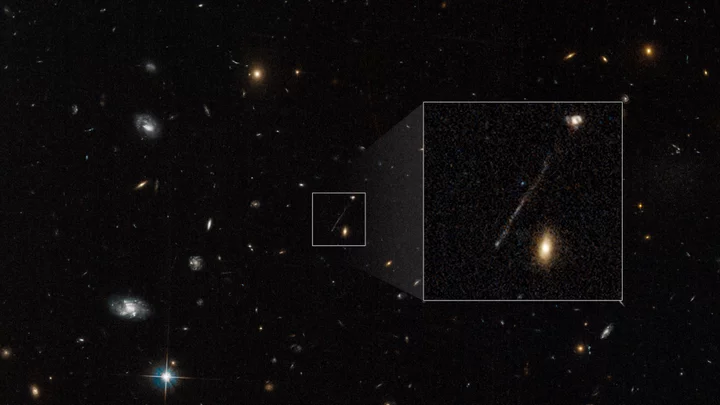If astronomers say they found a supermassive black hole sprinting 4 million mph away from its original galaxy, it's going to raise a few eyebrows.
Last month, The Astrophysical Journal Letters published a paper on a Hubble Space Telescope observation that described a bonkers scenario: a gigantic black hole traveling so fast it wasn't gobbling up stars and planets so much as it was lighting up space with a shimmery trail stretching 200,0000 light-years behind it. Pieter van Dokkum, an astronomy professor at Yale University, thought as the black hole plowed through an enormous cloud of gas, it must have been igniting new stars. NASA helped spread the word of his team's weird and seemingly unprecedented finding.
"Like the wake behind a ship, we’re seeing the wake behind the black hole,” he said in a statement in April.
But this idea was a little too outlandish for some, setting alight skepticism in the scientific community, with many researchers pondering other possible explanations. For one group at the Instituto de Astrofísica de Canarias in Spain, the answer cuts like Occam's razor: What if that "trail" is just a galaxy, and we're just seeing it from the side rather than face on?
SEE ALSO: NASA's new black hole video is jaw-droppingJorge Sanchez Almeida, lead author of a study that rebuts the runaway black hole hypothesis, said his team's explanation is so much simpler.
"The motions, the size, and the quantity of stars fits what has been seen in galaxies within the local universe," he said in a statement.
His group's analysis was recently published in a letter to the editor of the journal Astronomy and Astrophysics. If Almeida's team is right, it would make the cosmic feature something pretty ordinary by the universe's standards — a "bulgeless" galaxy, lacking a large collection of stars in the middle. Meanwhile, van Dokkum continues to hold tight to his black hole argument.
The cosmic oddity, top, is compared to two images of a well-known bulgeless galaxy, middle and bottom, to show how similar they are in the new group's study. Credit: ESA / NASA / HubbleThe new letter states that if it were a galaxy, it would be considered quite long, but it wouldn't be particularly rare. Thousands of this kind of galaxy — sometimes called "flat" or "thin" — are already known, the authors wrote. Its size is comparable to the Milky Way, though most galaxies as ancient as this thing, estimated to be 8 billion years old, are smaller.
To support their conclusion, the team compared the cosmic object to another galaxy without a bulge, IC5249, and found it was strikingly similar. The mystery object had about the same mass, and its velocities were consistent with galaxy rotation. Put another way, the team believes if it walks like a duck, swims like a duck, and quacks like a duck, then it probably is a duck.
"Indeed, it is a galaxy, which behaves like a galaxy," said Ignacio Trujillo, a co-author.
Want more science and tech news delivered straight to your inbox? Sign up for Mashable's Top Stories newsletter today.
Coming to this conclusion was bittersweet for Almeida. Runaway black holes have been predicted, even though no such fugitive has been discovered yet, he said: It would have been thrilling if this were the first.
Van Dokkum, on the other hand, hasn't given up on his original hypothesis. He is continuing his research, still believing what he found is a black hole on the lam.
Runaway black holes have been predicted, even though no such fugitive has been discovered and confirmed. Credit: NASA / ESA / Leah Hustak (STScI) illustrationRecently, he used a new far-ultraviolet light image to observe that the alleged "wake" can be traced all the way back to an origin galaxy, suggesting that the two are connected. A follow-up paper, now available on a preprint server, will be published in Research Notes of the American Astronomical Society.
Despite the new team's confidence, it's not an open-and-shut case. Scientists are planning more telescope observations to further study the oddity. And van Dokkum doesn't shy away from discussing the opposing arguments in his latest paper.
"The interpretation of this object will likely remain a topic of debate for some time," he wrote.









